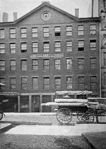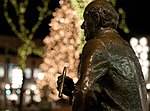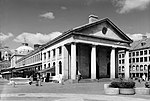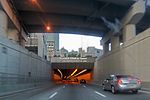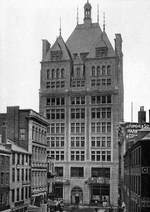Aquarium station (MBTA)

Aquarium station is an underground rapid transit station on the MBTA Blue Line in Boston, Massachusetts, United States. It is located under State Street at Atlantic Avenue on the eastern edge of Boston's Financial District near Boston Harbor. The station is named for the nearby New England Aquarium. It is adjacent to Long Wharf, which is used by two MBTA Boat lines. The station has two side platforms serving the two tracks of the Blue Line; an arched ceiling runs the length of the platform level. With the platforms 50 feet (15 m) below street level, it is the second-deepest station on the MBTA system (after Porter station). The Boston Elevated Railway (BERy) opened the Atlantic Avenue Elevated on August 22, 1901, with a station at State Street. The BERy opened the East Boston Tunnel under State Street and Long Wharf for streetcars on December 30, 1904. Construction of the intermediate station at Atlantic Avenue under the Elevated was delayed; it opened on April 5, 1906. Unlike other early stations in Boston, which were built with cut-and-cover tunneling, most of Atlantic Avenue station was built as a large barrel vault. The access shaft at the east end of the station was topped with a three-story headhouse, which included a footbridge to the elevated station. Four unusual angled elevators connected the headhouse to the platforms. In 1924, the Boston Transit Department implemented a long-planned project to convert the tunnel from streetcars to high-floor metro trains, with high platforms added at the station. The Atlantic Avenue Elevated closed in 1938, while the subway station remained open. In 1948, the city began replacing the old headhouse and elevators with a smaller structure and escalators. On January 28, 1949, a welder ignited a grease fire that exploded down an elevator shaft, killing three people and burning numerous others. The station was closed until the completion of the renovations in January 1950. The station was renamed Aquarium in 1967 as part of rebranding by the 1964-formed Massachusetts Bay Transportation Authority (MBTA). The MBTA began construction on a major renovation of the station in 1996. The platforms were lengthened for six-car trains, new entrances were added west of Atlantic Avenue, and the station was made fully accessible. The station was closed from October 14, 2000 to October 29, 2001; major construction was completed in 2003. Since the renovation, the station has had water leakage issues; it also occasionally floods during high tides and storm surges. The proposed North-South Rail Link includes a possible Central Station for MBTA Commuter Rail trains located under Aquarium station.
Excerpt from the Wikipedia article Aquarium station (MBTA) (License: CC BY-SA 3.0, Authors, Images).Aquarium station (MBTA)
McKinley Square, Boston Downtown Boston
Geographical coordinates (GPS) Address Nearby Places Show on map
Geographical coordinates (GPS)
| Latitude | Longitude |
|---|---|
| N 42.3593 ° | E -71.0531 ° |
Address
Custom House Tower (Marriott's Custom House Hotel)
McKinley Square 3
02109 Boston, Downtown Boston
Massachusetts, United States
Open on Google Maps


